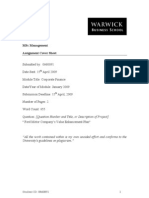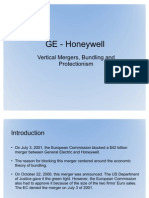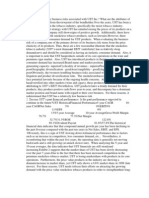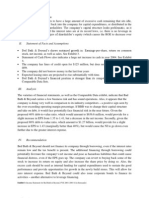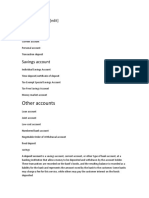CMF USTCase Report
CMF USTCase Report
Uploaded by
Amal DaherCopyright:
Available Formats
CMF USTCase Report
CMF USTCase Report
Uploaded by
Amal DaherOriginal Description:
Copyright
Available Formats
Share this document
Did you find this document useful?
Is this content inappropriate?
Copyright:
Available Formats
CMF USTCase Report
CMF USTCase Report
Uploaded by
Amal DaherCopyright:
Available Formats
CAPITAL MARKETS AND FINANCING SPR 13
Group Assignment 1
UST Case Study
2/19/2013
Capital Markets and Financing SPR13 Question 1:
UST Case Study
In order to calculate the impact of the leverage recapitalization on USTs value, we used the WACC and APV methods to calculate its value before and after the recapitalization. WACC Method Using the WACC method, we first derived USTs return on assets (rA). Since we are given the firms market capitalization, debt and cash, we calculated the current Enterprive Value of UST. We were then able to derive the return on asset as a function of USTs market value. Specifically, we followed the below steps: 1. We estimated $467.8 million as the free cash flow of UST in 1999 based on the given assumption that its operating cash flows will grow at a rate of 3% in perpetuity.
Free Cash Flow Sales EBITDA EBIT Tax Dep & Amort. CAPEX Working Capital Change in WC Free Operating Cash Flow
1423.2 785.0 753.3 287.6 31.7 35.5 309.9
1465.9 808.6 775.9 294.8 32.7 36.6 319.2 9.3 467.8
429.5
2. We calculated $6,537.6 million as USTs enterprise value as of the end of 1998 by adding together USTs market equity of $6,470.8 million and total debt of $100 million and subtracting cash of $33.2 million from this value. 3. Given the assumed growth rate of 3% and USTs free cash flow in 1999 and enterprise value, we derived 10.16% as the WACC from the growing perpetuity formula: ( ).
4. We derived 10.22% as the rA from the WACC formula:
In the presence of taxes, the WACC equals rA if the company is 100% equity-financed. Hence, instinctively, we can expect the WACC and rA to be closely equivalent in the case of UST due to its low leverage ratio of 1.52% prior to the recapitalization. Once we have derived the rA, we re-calculated the WACC before and after the recapitalization using the formula: ( ) Given these WACCs, we obtained USTs value . 1
before and after the recapitalization using the growing perpetuity formula:
Capital Markets and Financing SPR13
Value - Before Additional Debt Return on Asset Tax Rate Debt Debt / Value WACC Free Cash Flow Growth Rate Value Value - After New Debt Issuance Return on Asset Tax Rate Debt Debt / Value WACC Free Cash Flow Growth Rate Value
UST Case Study
10.22% 38% 100 1.5% 10.16% 467.8 3% 6537.87
10.22% 38% 1100 15.5% 9.61% 467.8 3% 7075.87
As expected, the WACC decreased from 10.16% to 9.61% after the recapitalization due to the higher leverage ratio resulting in increased tax savings. The decrease in WACC then resulted to the increase in USTs value from $6,537.87 million to $7,075.87 million. APV Method Using the APV method, we determined the value of UST by adding its enterprise value prior to the recapitalization (as computed above) and the present value of the tax shield caused by the increase in its leverage. To calculate the present value of the tax shield, we used the formula: ( )
. We derived the cost of debt (rD) of 7.05% by estimating A as the new credit rating of UST after recapitalization.1 We took the 20-year interest rate given debt is perpetual. Since UST has a high coverage ratio, we assumed that the cost of the tax shield (rTS) is equal to rD. Given the debt is not growing, the cost of debt used to calculate interest rate cancelled out with the discount factor so in this particular case, credit rating did not affect tax shield calculations.
Value - APV Method Initial Value New Debt Tax Rate Cost of Debt Value of Tax Shield PV of Tax Shield New Value
6537.87 1,000 38% 6.12% 23.256 380 6,918
Similar to the results in the WACC method, the increase in leverage resulted in an increase in USTs value.
For further discussion of the credit rating, please see answer to Question 2 below.
Capital Markets and Financing SPR13 Question 2:
UST Case Study
In order to arrive at the cost of debt, we need to observe a credit rating for the company. Considering UST only had short-term debt issues prior to the recapitalization, and that credit ratings depend on maturity of debt issued, we cannot simply rely on the commercial paper ratings to extrapolate. We assume that rating will be A based on competitors ratings as well as USTs overall financial standing. We then use this assumption to calculate the value of the company using the two methods above. We assume linear increase in the EBIT and EBITDA at 3% for 1999 from 1998 figures. Considering the debt will be long-term, we test both 10- and 20-year corporate yields as interest rates to see what would be the coverage ratios, using the 1999 projected figures.2
Interest Coverage Ratios (Based on 10-year interest rates) 1999 Interest Rate EBITDA Interest Coverage (x) EBIT Interest Coverage (x) AAA 5.60 14.44 13.86 AA 5.84 13.85 13.29 A 6.12 13.21 12.68 BBB 6.84 11.82 11.34 BB+ 7.70 10.50 10.08 BB/BB8.72 9.27 8.90 BB 11.19 7.23 6.93
Interest Coverage Ratios (Based on 20-year interest rates) 1999 Interest Rate EBITDA Interest Coverage (x) EBIT Interest Coverage (x) AAA 6.47 12.50 11.99 AA 6.76 11.96 11.48 A 7.05 11.47 11.01 BBB 7.82 10.34 9.92 BB+ ---BB/BB---BB ----
Based on the calculations of the EBIT and EBITDA interest coverage ratios we conclude that the expected credit rating for the new debt will be A (based on the data presented in Exhibit 8 and assuming conservative outlook). However, based on the Standard & Poors report on the tobacco industry, there are additional issues to address, including litigation risk, declining sales, lack of diversification, and marketing restrictions coupled with lack of international expansion. In addition to lawsuits related to health hazards of tobacco use, UST is facing and may face in the future an antitrust dispute. Depending on the outcome of these and any future lawsuits, UST may not be in a position to make payments to service its debt. We believe this likelihood is remote and that obligors capacity to meet financial commitment on obligation is still strong.3 The future outlook of the company would probably be defined as Neutral (neither strong positive nor negative trends in the near future). The sales and market share of UST have been declining in the recent past, but the management is committed to stopping this trend and has managed to stabilize the market share. Furthermore, the decline would likely not adversely impact the ability of UST to meet financial commitments at the current rate, as UST still has the biggest market share in the US. The majority of the sales and operating profit of UST come from smokeless tobacco (88% and 97%, respectively4), whereas the
For completeness, we test the coverage ratios using 1998 figures as well, and the results do not change in a meaningful manner. 3 Debt Policy at UST Inc. Harvard Business School, 9-200-069, May 3, 2001, Exhibit 7. 4 Debt Policy at UST Inc. Harvard Business School, 9-200-069, May 3, 2001, p. 5.
Capital Markets and Financing SPR13
UST Case Study
wine and other businesses account for the rest. In a case of severe disruption to the smokeless tobacco industry, the ability of UST to service debt may be drastically diminished. As presented in the case, UST has no immediate opportunity for international expansion,5 implying that the possibility of counteracting any US market declines would not be really high. Brand name recognition of UST is very high and the company boasts a very strong legacy. Furthermore, smokeless tobacco industry has been growing overall, mostly due to smoking indoors restrictions and customers switching to smokeless tobacco. Perception that smokeless tobacco poses less of a health hazard has also helped in the customer switching. Considering all of the above factors, as well as the interest rate coverage ratios, we can conclude that S&P would rate the newly issued debt at A, with neutral outlook.
Question 3 We believe the decision to restructure the capitalization of UST was a good decision by management which will prove to be accretive for shareholders. This decision results in a 380m present value of tax shields for the firm (not accounting for bankruptcy costs). This is 5% of the current firms value, which is quite sizable for equity investors. Increasing leverage will only result in an increase in firm value if the present value of tax shields is greater than the associated agency and bankruptcy costs. In this particular case, due to USTs strong financial position (11x EBITDA coverage and only 1.2x D/EBITDA), we believe that the increase in bankruptcy and associated costs are fairly small and negligible. To be sure, we can see from the table below that AA-A rating downgrade has historically increased the probability of default between 0.8% and 1.4%. Thus, even if we assume that the probability of default increases by 1.4% and we have a binary situation in which either the firm defaults (value of $0 to be conservative and ignore recovery) and or stays solvent, the associated expected loss would be an incremental $91m (1.4%*6537EV), which is considerably lower than the $380m gain.
Cumulative Historic Default Rates (in percent)
Moodys Rating category Aaa/AAA Aa/AA A/A Baa/BBB Ba/BB B/B Caa-C/CCC-C
5
S&P Corp 0.52 0.52 1.29 4.64 19.12 43.34 69.18 Muni 0.00 0.00 0.23 0.32 1.74 8.48 44.81 Corp 0.60 1.50 2.91 10.29 29.93 53.72 69.19
Muni 0.00 0.06 0.03 0.13 2.65 11.86 16.58
Debt Policy at UST Inc. Harvard Business School, 9-200-069, May 3, 2001, p. 6.
Capital Markets and Financing SPR13
Averages Investment grade Non-investment grade All 0.07 4.29 0.10 2.09 31.37 9.70
UST Case Study
0.20 7.37 0.29
4.14 42.35 12.98
Source: U.S. Municipal Bond Fairness Act, 2008. http://monevator.com/bond-default-rating-probability/
Moreover, this decision should satisfy the shareholders as it reinstates the repurchase program that was stopped in 1997. This will result in increased EPS (which may be cosmetic, but important in the eyes of Wall Street analysts) and a higher return on equity. Since ROE is driven by profit margins, asset turnover and financial leverage, as long as the firm can find positive NPV projects the ROE should increase. On the contrary, the shareholders may be cautious since the increased leverage increases the Re, and risk on equity. Furthermore, if the company faces unexpected shocks to cash flows, the shareholders will be much more susceptible to volatility as they are last in the pecking order. The fact that the tobacco industry faces such high litigation risk and structural uncertainties makes this risk a legitimate concern. Lastly, we evaluated the signals that this action will give to the market and believe that it is a net positive signal. As was mentioned in the case analysts remain concerned about price-value competitorstobacco marketand [that] UST has no immediate opportunity for international expansion. The increase in debt/ decrease in equity should signal to the market that the company is robust against perceived adverse threats. If they are able to raise $1b debt, that has a high quality rating, they can show that they are viewed as high quality (since they would not be able to cheaply finance otherwise) and that they are confident they are able to service the debt. Had they been concerned about financial impairment, they would not have loaded debt on their balance sheet. Furthermore, it is noted that the market has concerns that the company may over-invest in negative NPV projects. We believe this action also signals that the management is prudent in this respect. First, since he is buying back shares, it signals that if they do not see a positive NPV project, they would rather return the money in the form of a dividend (share buyback) to shareholders. Second, with extra cash on hand, it may signal that the firm is opportunistically looking for investment opportunities with positive returns.
You might also like
- Marriott CaseDocument6 pagesMarriott CaseBeibei31475% (4)
- Case Analysis - Cost of CapitalDocument5 pagesCase Analysis - Cost of CapitalHazraphine Linso67% (3)
- UST Final CaseDocument4 pagesUST Final Casestrongchong0050% (2)
- Ford Motor Company's Value Enhancement PlanDocument3 pagesFord Motor Company's Value Enhancement PlanVistasp Major100% (1)
- Debt Policy at Ust Case SolutionDocument2 pagesDebt Policy at Ust Case Solutiontamur_ahan50% (2)
- Ust Inc Case SolutionDocument16 pagesUst Inc Case SolutionJamshaid Mannan100% (2)
- West Teleservice: Case QuestionsDocument1 pageWest Teleservice: Case QuestionsAlejandro García AcostaNo ratings yet
- Debt Policy at Ust Inc Case StudyDocument7 pagesDebt Policy at Ust Inc Case StudyAnton Borisov100% (1)
- Padgett Paper Products Case StudyDocument7 pagesPadgett Paper Products Case StudyDavey FranciscoNo ratings yet
- MFIN Case Write-UpDocument7 pagesMFIN Case Write-UpUMMUSNUR OZCANNo ratings yet
- Portfolio QsDocument3 pagesPortfolio QsTom Psy50% (2)
- Hbs Case - Ust Inc.Document4 pagesHbs Case - Ust Inc.Lau See YangNo ratings yet
- Case Study: Midland Energy Resources, IncDocument13 pagesCase Study: Midland Energy Resources, IncMikey MadRatNo ratings yet
- Polaroid Corporation: Group MembersDocument7 pagesPolaroid Corporation: Group MemberscristinahumaNo ratings yet
- Sally Jameson CaseDocument2 pagesSally Jameson Casemaniaa545No ratings yet
- Warren Buffett Case AnswerDocument5 pagesWarren Buffett Case Answeryunn lopNo ratings yet
- How To Valuation A CompanyDocument42 pagesHow To Valuation A Companyapi-3720563100% (3)
- Nike Case StudyDocument5 pagesNike Case StudyxluciastanNo ratings yet
- Marriot Corp. Finance Case StudyDocument5 pagesMarriot Corp. Finance Case StudyJuanNo ratings yet
- Marriot Corp. - Cost of CapitalDocument6 pagesMarriot Corp. - Cost of Capitalone990scribdNo ratings yet
- Various Stages of Venture Capital FinancingDocument68 pagesVarious Stages of Venture Capital Financingjoy9crasto92% (12)
- Debt Policy at UST IncDocument5 pagesDebt Policy at UST Incggrillo73No ratings yet
- UST IncDocument16 pagesUST IncNur 'AtiqahNo ratings yet
- Case Analysis - Cost of CapitalDocument5 pagesCase Analysis - Cost of CapitalHazraphine LinsoNo ratings yet
- Corporate Finance UST CaseDocument7 pagesCorporate Finance UST Casepradhu1100% (1)
- Ust SolutionDocument3 pagesUst SolutionAdeel_Akram_Ch_9271No ratings yet
- UST Debt Policy SpreadsheetDocument9 pagesUST Debt Policy Spreadsheetjchodgson0% (2)
- Corp Finance HBS Case Study: Debt Policy at UST IncDocument4 pagesCorp Finance HBS Case Study: Debt Policy at UST IncTang LeiNo ratings yet
- Debt Policy at Ust IncDocument18 pagesDebt Policy at Ust InctutenkhamenNo ratings yet
- case-UST IncDocument10 pagescase-UST Incnipun9143No ratings yet
- Case Questions-Debt Policy at USTDocument1 pageCase Questions-Debt Policy at USTSandeep BhatNo ratings yet
- Corporate Finance Practice ExamDocument11 pagesCorporate Finance Practice ExamPeng Jin100% (1)
- Debt Policy at Ust Inc Case AnalysisDocument23 pagesDebt Policy at Ust Inc Case AnalysisLouie Ram50% (2)
- GE Honeywell.Document20 pagesGE Honeywell.Sripal ShahNo ratings yet
- Jet IPO ValuationDocument2 pagesJet IPO Valuationprtkshnkr50% (2)
- Mercury Athletic G7Document11 pagesMercury Athletic G7Nanda PallerlaNo ratings yet
- Debt Policy at UST Inc.Document47 pagesDebt Policy at UST Inc.karthikk1990100% (2)
- USTDocument4 pagesUSTJames JeffersonNo ratings yet
- List of Questions PDFDocument1 pageList of Questions PDFimagineimfNo ratings yet
- Case2 Team4 v4Document7 pagesCase2 Team4 v4whatifknowNo ratings yet
- FIN RealOptionsDocument3 pagesFIN RealOptionsveda20No ratings yet
- Debt Policy at UST Inc.Document11 pagesDebt Policy at UST Inc.Omkar BibikarNo ratings yet
- MarriotDocument3 pagesMarriotNaman SharmaNo ratings yet
- Nike Case AnalysisDocument9 pagesNike Case AnalysisFami FamzNo ratings yet
- BBB Case Write-UpDocument2 pagesBBB Case Write-UpNeal Karski100% (1)
- Debt Policy at Ust IncDocument18 pagesDebt Policy at Ust Incapi-371968794% (16)
- Topic6 Interest Rates and Bond ValuationDocument2 pagesTopic6 Interest Rates and Bond ValuationJaskeerat SinghNo ratings yet
- Mellon Valuation AnalysisDocument7 pagesMellon Valuation AnalysisAmber Hill100% (1)
- Case Study Debt Policy Ust IncDocument10 pagesCase Study Debt Policy Ust IncIrfan MohdNo ratings yet
- Marketing DossierDocument38 pagesMarketing DossierTigran WadiaNo ratings yet
- Assignment 4 or Poject Phase 1 (Walmart by Mehdi & Salman)Document28 pagesAssignment 4 or Poject Phase 1 (Walmart by Mehdi & Salman)Syed Mehdi BukhariNo ratings yet
- LittleField Technology CaseDocument22 pagesLittleField Technology CaseMubeen Qawi0% (2)
- Gemini ElectronicsDocument1 pageGemini ElectronicsSreeda PerikamanaNo ratings yet
- Marriott Case Analysis - FinalDocument7 pagesMarriott Case Analysis - FinalvasanthaNo ratings yet
- Marvel EnterprisesDocument8 pagesMarvel Enterprisesalsaban_7No ratings yet
- Problems and Questions - 3Document6 pagesProblems and Questions - 3mashta04No ratings yet
- Duke Finance Adjusted NPVDocument9 pagesDuke Finance Adjusted NPVbgraham421No ratings yet
- AssignmentDocument5 pagesAssignmentcs1231No ratings yet
- Caso 4 MarriotDocument12 pagesCaso 4 MarriotbxuffyNo ratings yet
- Valuation Gordon Growth ModelDocument25 pagesValuation Gordon Growth ModelwaldyraeNo ratings yet
- Corporate FinanceDocument15 pagesCorporate Financecaglar ozyesilNo ratings yet
- Butler Lumber Final First DraftDocument12 pagesButler Lumber Final First DraftAdit Swarup100% (3)
- Profitability AnalysisDocument9 pagesProfitability AnalysisAnkit TyagiNo ratings yet
- DU Pont AnalysisDocument2 pagesDU Pont Analysisjennna89No ratings yet
- Stimulating Long Term ShareholdingDocument69 pagesStimulating Long Term ShareholdingAniruddha RoyNo ratings yet
- Analytical VaR VaR MappingDocument13 pagesAnalytical VaR VaR MappingFuad SheikhNo ratings yet
- Secret Case FilesDocument51 pagesSecret Case FilesWong Wan YinNo ratings yet
- Acc Cements: India's No. 1 Cement CompanyDocument26 pagesAcc Cements: India's No. 1 Cement CompanyAmol PakhaleNo ratings yet
- Auditing (Problems) Book Value Per ShareDocument12 pagesAuditing (Problems) Book Value Per ShareJasper Bryan BlagoNo ratings yet
- امتحان الكفاءة الجامعي.شركاتDocument13 pagesامتحان الكفاءة الجامعي.شركاتديـنـا عادلNo ratings yet
- Clearing and Settlement - DTCC - Following How A Trade Gets ClearedDocument8 pagesClearing and Settlement - DTCC - Following How A Trade Gets ClearedAsha Pagdiwalla100% (2)
- AggrivateDocument14 pagesAggrivatemvtharish138No ratings yet
- MT Quiz 1 MasterDocument2 pagesMT Quiz 1 MasterChristine Dela Rosa CarolinoNo ratings yet
- Midland Energy Resources Case AssignmentDocument10 pagesMidland Energy Resources Case AssignmentAndrew ChoiNo ratings yet
- Bonia - Annual Report 2016 (Part 3)Document126 pagesBonia - Annual Report 2016 (Part 3)ameraizahNo ratings yet
- Types of AccountDocument4 pagesTypes of AccountArslan AshfaqNo ratings yet
- Illiquidity and Stock Returns: Cross-Section and Time-Series EffectsDocument26 pagesIlliquidity and Stock Returns: Cross-Section and Time-Series EffectsSohanur RahmanNo ratings yet
- AIG Annual Report 2007Document276 pagesAIG Annual Report 2007highfinance100% (4)
- "MMM Eating Corner Café" Business PlanDocument21 pages"MMM Eating Corner Café" Business PlanMarianna RetziNo ratings yet
- BNPParibasDocument31 pagesBNPParibasHm VikramNo ratings yet
- DataWatch May 2013Document33 pagesDataWatch May 2013ZE PowerGroup Inc.No ratings yet
- 13-Theory (85-89)Document12 pages13-Theory (85-89)Sameer HussainNo ratings yet
- FIN601 Lect Topic 3Document53 pagesFIN601 Lect Topic 3Vikash Son100% (1)
- MTBSL: MTB Securities LimitedDocument2 pagesMTBSL: MTB Securities Limitedasdfghjkl007No ratings yet
- Financial AnalysisDocument23 pagesFinancial AnalysisRead BukuNo ratings yet
- Intraday MomentumDocument45 pagesIntraday MomentumJingyi GuoNo ratings yet
- Chapter 9 Ratio Analysis1Document65 pagesChapter 9 Ratio Analysis1niovaleyNo ratings yet
- An Introduction To Portfolio ManagementDocument11 pagesAn Introduction To Portfolio ManagementHogo DewenNo ratings yet
- Financial Statement Analysis - SSGC PakistanDocument29 pagesFinancial Statement Analysis - SSGC PakistanMurtaza AliNo ratings yet



